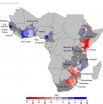(Press-News.org) Viruses designed to target and kill cancer cells could boost the effectiveness of chemotherapy to the arms and legs and help avoid amputation, a new study reports.
Scientists at The Institute of Cancer Research, London, tested the effectiveness of a genetically engineered version of the virus used to vaccinate against smallpox.
They found use of the virus alongside isolated limb perfusion chemotherapy – given directly to blood vessels supplying the affected arm or leg as an alternative to amputation – was more effective in rats than either treatment on its own.
The study, published in the International Journal of Cancer today (Tuesday), was funded by the Dr Lucy M Bull Lectureship and Research Fund and supported by the NIHR Biomedical Research Centre at The Royal Marsden NHS Foundation Trust and The Institute of Cancer Research (ICR), with additional funding from The Royal College of Surgeons of England and Sarcoma UK.
Researchers at the ICR, in collaboration with colleagues at The Royal Marsden, used a vaccinia virus known as GLV-1h68. This virus had been modified to infect and kill cancer cells.
The study suggests that the combination, if successful in the clinic, could help some skin cancer and sarcoma patients avoid radical surgery or amputation, greatly improving their quality of life. A clinical trial to test the combination in cancer patients has now been approved and is expected to take place in the near future.
Isolated limb perfusion uses a heart and lung bypass machine connected to the arm or leg to separate its blood supply from the rest of the body. This allows a high dose of a chemotherapy drug (in this case melphalan) to be given directly and specifically to the diseased limb without causing toxic side-effects to the rest of the body.
Chemotherapy is given alongside a drug called tumour necrosis factor-alpha (TNF-α) which helps make blood vessels more leaky, allowing melphalan to get to the tumour more effectively. In this study, researchers found that TNF- α also helped the virus get to the tumour more easily.
Researchers first tested the treatments on rat sarcoma cells in tissue culture, and found combining modified vaccinia virus and melphalan killed more cells than either treatment on its own.
They tested the combination in rats with advanced sarcoma and found it slowed tumour growth and prolonged survival by 50% compared to standard ILP therapy (melphalan and TNF-α). Rats given the combined therapy survived a median of 24 days, compared to 16 days for rats who received standard limb perfusion treatment, 15 days with the modified virus alone, and 11 days with no treatment. They saw the modified virus had no adverse effects on the rats, adding to existing evidence that the virus has a good safety profile.
Isolated limb perfusion allows drugs to be given in much higher doses than could be tolerated by the whole body. It is used by doctors as a last line of treatment for advanced skin cancer or sarcomas in the hope of avoiding amputation. However, the technique is not always successful and researchers have been searching for ways to make the approach more effective.
Professor Kevin Harrington, Professor of Biological Cancer Therapies at The Institute of Cancer Research, London, and Honorary Consultant at The Royal Marsden NHS Foundation Trust, said: "Our research shows that a virus that targets and kills cancer cells could significantly improve an existing treatment for advanced skin cancer and sarcoma in the arms and legs. Combining modified virus and isolated limb chemotherapy doubled survival times in the laboratory, which gives us hope that it might be effective in the clinic. We have approval to start clinical trials on the combination therapy and hope to begin testing in patients in the near future.
"The beauty of this technique is that the arm or leg is isolated, making it harder for the virus to be destroyed by the immune system – something that has been a stumbling block for virus treatments in the past. The study also showed that the virus didn't cause any adverse effects, adding to evidence that it should be safe to use as a cancer treatment.
Professor Paul Workman, Deputy Chief Executive of The Institute of Cancer Research, London, said: "Viral therapies have been suggested as a possible treatment for cancer for a number of years, but trials of cancer-killing viruses alone have not proved effective enough. Combining cancer-killing viruses with chemotherapy gives the tumour a double hit that could offer an improvement over existing treatment, and might help cancer patients avoid amputation."
INFORMATION:
For more information about this research, for a copy of the paper or to request an interview, please contact Graham Shaw in The Institute of Cancer Research media team on 020 7153 5380 or graham.shaw@icr.ac.uk. For enquiries out of office hours, please call 07969 082 520.
The Institute of Cancer Research, London, is one of the world's most influential cancer research institutes.
Scientists and clinicians at The Institute of Cancer Research (ICR) are working every day to make a real impact on cancer patients' lives. Through its unique partnership with The Royal Marsden Hospital and 'bench-to-bedside' approach, the ICR is able to create and deliver results in a way that other institutions cannot. Together the two organisations are rated in the top four cancer centres globally.
The ICR has an outstanding record of achievement dating back more than 100 years. It provided the first convincing evidence that DNA damage is the basic cause of cancer, laying the foundation for the now universally accepted idea that cancer is a genetic disease. Today it leads the world at isolating cancer-related genes and discovering new targeted drugs for personalised cancer treatment.
As a college of the University of London, the ICR provides postgraduate higher education of international distinction. It has charitable status and relies on support from partner organisations, charities and the general public.
The ICR's mission is to make the discoveries that defeat cancer. For more information visit http://www.icr.ac.uk
The Royal Marsden NHS Foundation Trust
The Royal Marsden opened its doors in 1851 as the world's first hospital dedicated to cancer diagnosis, treatment, research and education.
Today, together with its academic partner, The Institute of Cancer Research (ICR), it is the largest and most comprehensive cancer centre in Europe treating over 50,000 NHS and private patients every year. It is a centre of excellence with an international reputation for groundbreaking research and pioneering the very latest in cancer treatments and technologies.
The Royal Marsden, with the ICR, is the only National Institute for Health Research Biomedical Research Centre for Cancer. First awarded the status in 2006, it was re-awarded in 2011. A total of £62 million is being provided over five years, to support pioneering research work, and is being shared out over eight different cancer themes.
The Royal Marsden also provides community services in the London boroughs of Sutton and Merton and in June 2010, along with the ICR, the Trust launched a new academic partnership with Mount Vernon Cancer Centre in Middlesex.
Since 2004, the hospital's charity, The Royal Marsden Cancer Charity, has helped raise over £100 million to build theatres, diagnostic centres, and drug development units.
Prince William became President of The Royal Marsden in 2007, following a long royal connection with the hospital.
Viral therapy could boost limb-saving cancer treatment
2014-07-22
ELSE PRESS RELEASES FROM THIS DATE:
New study finds high school lacrosse players at risk for concussions, other injuries
2014-07-22
Lacrosse is one of the fastest-growing high school sports in the United States, with more than 170,000 students now playing the sometimes hard-hitting game. The growing participation numbers, however, mean that more young people than ever are at risk of injury in lacrosse practice and competition.
In a study published online today by The American Journal of Sports Medicine and available in an upcoming print issue, researchers from the Center for Injury Research and Policy at Nationwide Children's Hospital and the Colorado School of Public Health found that high school ...
Schizophrenia's genetic 'skyline' rising
2014-07-22
The largest genomic dragnet of any psychiatric disorder to date has unmasked 108 chromosomal sites harboring inherited variations in the genetic code linked to schizophrenia, 83 of which had not been previously reported. By contrast, the "skyline" of such suspect variants associated with the disorder contained only 5 significant peaks in 2011. By combining data from all available schizophrenia genetic samples, researchers supported by the National Institutes of Health powered the search for clues to the molecular basis of the disorder to a new level.
"While the suspect ...
Largest gene discovery 'kick-starts' new search for schizophrenia treatments
2014-07-22
VIDEO:
Largest gene discovery helps 'kick-start' new search for schizophrenia treatments - The discovery of over a hundred genetic risk factors linked to schizophrenia provides vital new clues in understanding what...
Click here for more information.
The discovery of over a hundred genetic risk factors linked to schizophrenia provides vital new clues in understanding what causes the condition and will kick-start the search for new treatments, according to leading UK scientists. ...
International team sheds new light on biology underlying schizophrenia
2014-07-22
July 21, 2014 (Toronto) – As part of a multinational, collaborative effort, researchers from Canada's Centre for Addiction and Mental Health (CAMH) have helped identify over 100 locations in the human genome associated with the risk of developing schizophrenia, in what is the largest genomic study published on any psychiatric disorder to date. The findings, published online in Nature, point to biological mechanisms and pathways that may underlie schizophrenia, and could lead to new approaches to treating the disorder, which has seen little innovation in drug development ...
LSU's Mark Batzer contributes to Nature Genetics article on marmoset genome
2014-07-21
BATON ROUGE – LSU's Mark Batzer, Boyd Professor and Dr. Mary Lou Applewhite Distinguished Professor in Department of Biological Sciences in the College of Science, contributed to an article in the scientific journal Nature Genetics, titled "The Common Marmoset Genome Provides Insight into Primate Biology and Evolution," published on July 20.
Batzer contributed analysis of "jumping genes," or mobile elements that move by a sort of "copy and paste" mechanism in the genome. The marmoset is important because it is the first "New World" monkey genome to be sequenced.
An ...
Temple study compares deep vein thrombosis therapies
2014-07-21
(Philadelphia, PA) – Patients who have a clot in their legs and are considering whether to be treated with traditional blood-thinning medication or undergo a minimally-invasive catheter-based clot removal procedure should feel comfortable that there is no difference in death rates between the two treatments, although there are more bleeding risks with the catheter procedure, according to a study by Temple University School of Medicine researchers. The study involved a review of more than 90,000 cases nationwide.
Riyaz Bashir, MD, a specialist in interventional cardiology ...
'Moral victories' might spare you from losing again
2014-07-21
It's human nature to hate losing.
Unfortunately, it's also human nature to overreact to a loss, potentially abandoning a solid strategy and thus increasing your chances of losing the next time around.
That's one conclusion of a Brigham Young University study published this week by the journal Management Science. The finding is based on an analysis of two decades of data on NBA coaching decisions.
The researchers focused on whether coaches adjusted their personnel following games where the margin of victory or defeat was small. After narrow wins, coaches changed their ...
Water, water -- not everywhere: Mapping water trends for African maize
2014-07-21
Today's food production relies heavily on irrigation, but across sub-Saharan Africa only 4 percent of cultivated land is irrigated, compared with a global average of 18 percent. Small-scale farming is the main livelihood for many people in the region, who depend on rainfall to water their crops.
To understand how climate change may affect the availability of water for agriculture, researchers at Princeton University analyzed trends in the water cycle in maize-growing areas of 21 African countries between 1979 and 2010. The team examined both levels of rainfall and the ...
Global warming 'pause' since 1998 reflects natural fluctuation
2014-07-21
Statistical analysis of average global temperatures between 1998 and 2013 shows that the slowdown in global warming during this period is consistent with natural variations in temperature, according to research by McGill University physics professor Shaun Lovejoy.
In a paper published this month in Geophysical Research Letters, Lovejoy concludes that a natural cooling fluctuation during this period largely masked the warming effects of a continued increase in man-made emissions of carbon dioxide and other greenhouse gases.
The new study applies a statistical methodology ...
Mammoth and mastodon behavior was less roam, more stay at home
2014-07-21
Their scruffy beards weren't ironic, but there are reasons mammoths and mastodons could have been the hipsters of the Ice Age.
According to research from the University of Cincinnati, the famously fuzzy relatives of elephants liked living in Greater Cincinnati long before it was trendy – at the end of the last ice age. A study led by Brooke Crowley, an assistant professor of geology and anthropology, shows the ancient proboscideans enjoyed the area so much they likely were year-round residents and not nomadic migrants as previously thought.
They even had their own ...



